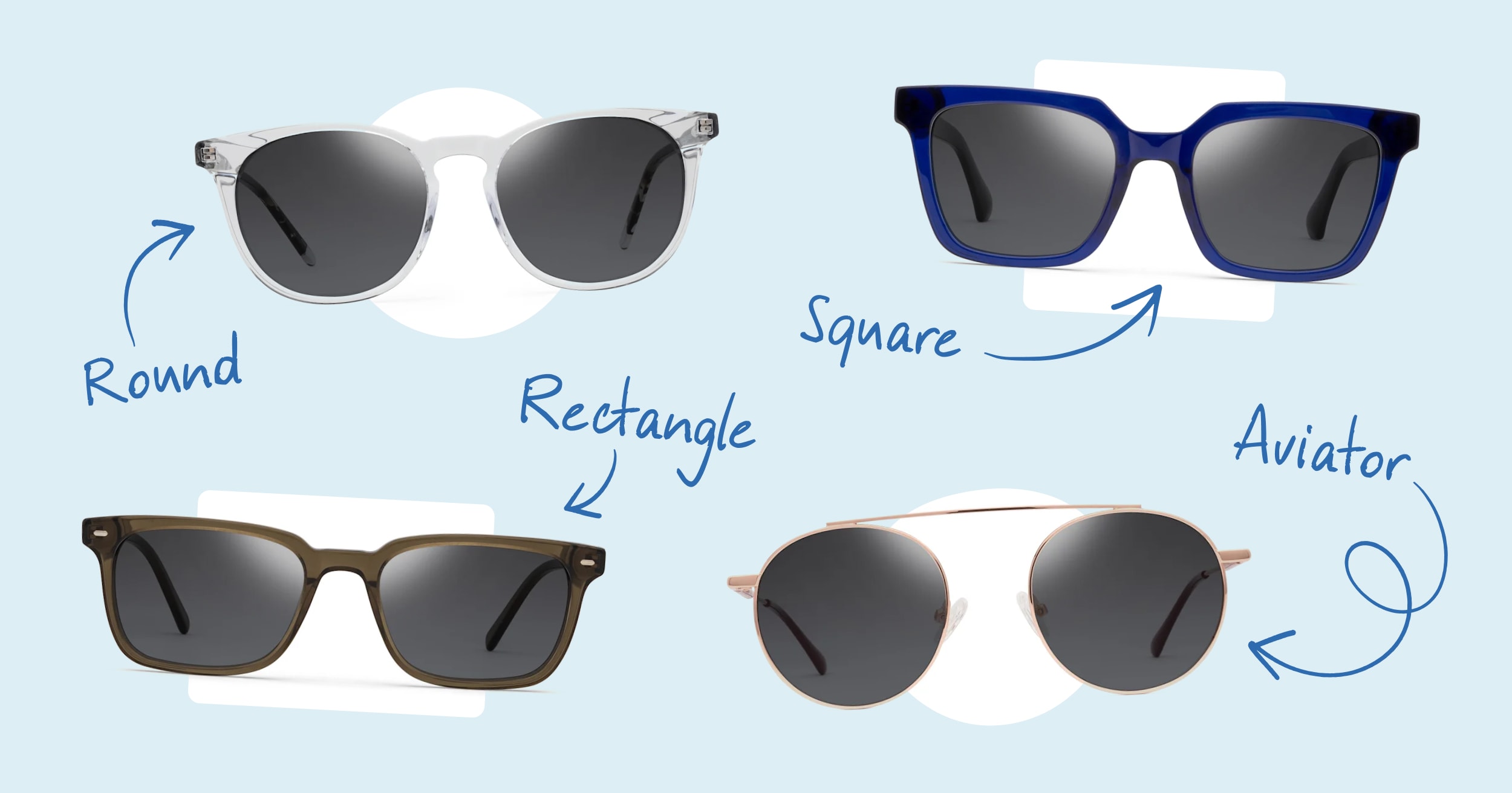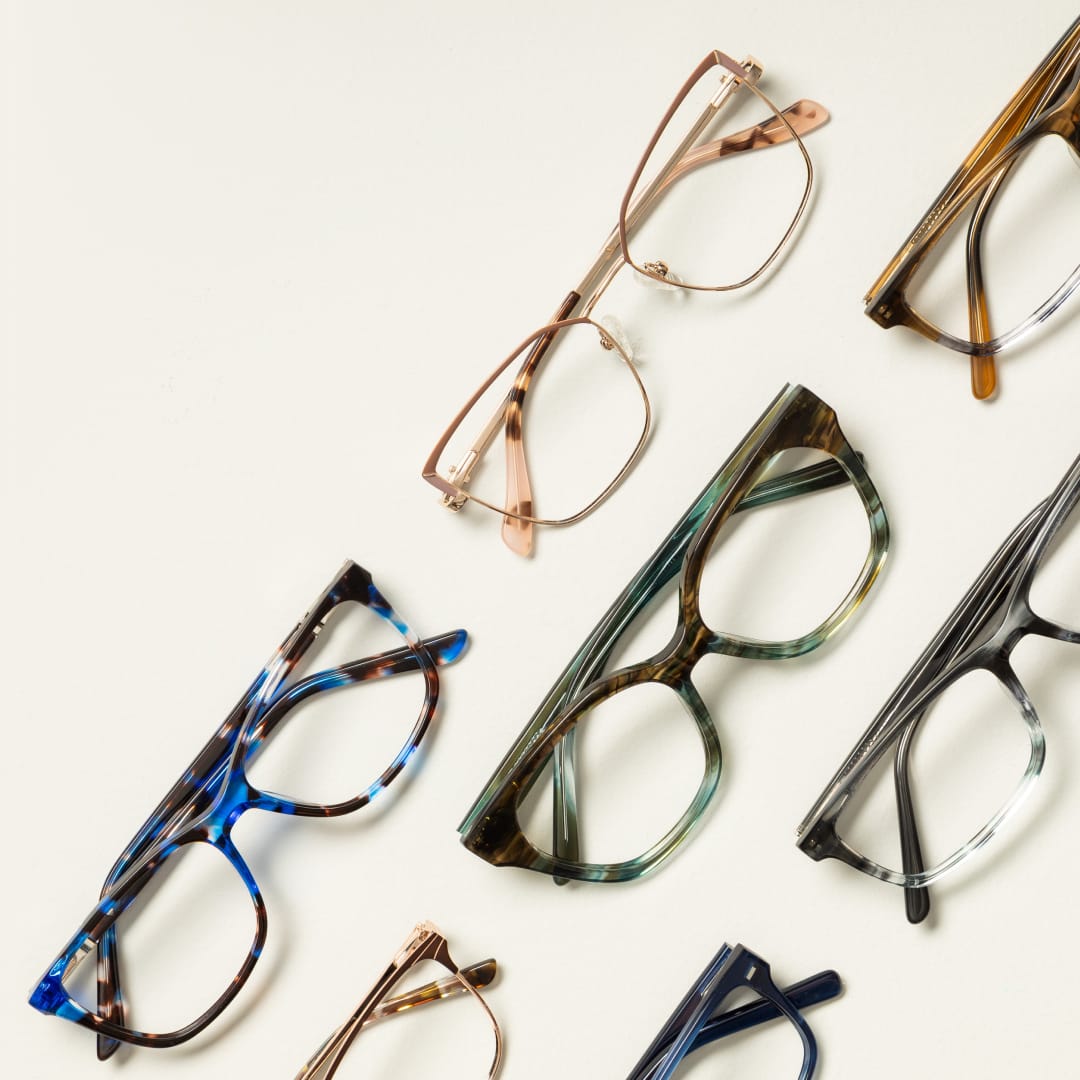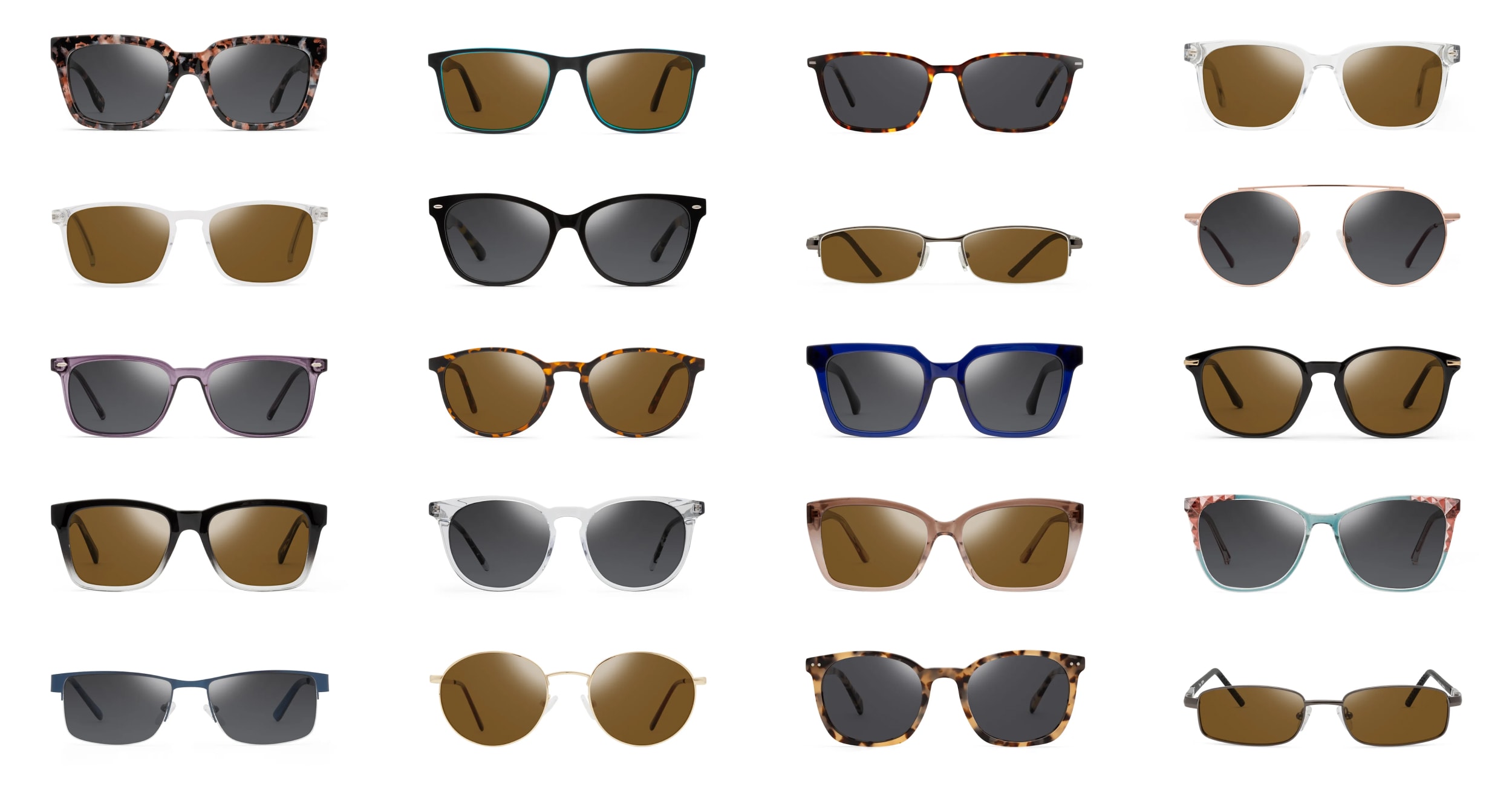Types of sunglasses
-
Round: A vintage-inspired circular sunglasses frame ideal for square or heart-shaped faces
-
Square: A bold geometric design suited for round or oval face shapes
-
Rectangle: A sleek style suited for fuller face shapes, including round faces
-
Geometric: An edgy look with exaggerated angles ideal for round or oval faces
-
Aviator: A military-inspired, sleek look suited for oval faces
-
Browline: A style with defined upper frame that looks great with oval or triangle-shaped faces
-
Cat-eye: An upswept frame ideal for oval or heart-shaped faces
-
Wayfarer: A slightly tapered square design suited for heart-shaped or round faces
-
Clubmaster: A bold frame with thin rims that looks great on diamond-shaped or oval faces
-
Tactical: A rugged frame suited for oblong or oval faces

Can you only wear flirty cat-eye sunglasses if your face is heart-shaped or oval? Will the sunglasses police show up to arrest your aviators if you've paired them with a tear-drop face shape? Absolutely not: When it comes to sunglasses style, your personal preference is the final word.
That being said, understanding the types of sunglasses so you can make the right choice to protect your pretty peepers is important. Sunglasses are more technical than you might think, but we've got you covered with a guide that covers styles, shapes, tinting, UV protection, polarization, and what makes sunglasses different from regular glasses.
How do sunglasses differ from real glasses?
"Real" glasses in this context refers to glasses that have a primary purpose of correcting vision. In contrast, the primary purpose of sunglasses is to protect your eyes from harmful UV rays and block glare so you have better visibility in bright environments.
Can one pair of glasses do all those things? Sure. But you probably wouldn't wear prescription sunglasses in a dark room to read a book, right? Because they have a different purpose.
Another main difference between sunglasses and standard glasses is that sunglass lenses are typically more tinted — that's all part of blocking glare and UV rays.
What do standard glasses and sunglasses have in common? Well, you wear both on the face, obviously. They're both available in many sizes, colors, and shapes, and you can get glass, plastic, or polycarbonate lenses in either type of glasses. Most of the time, however, sunglasses are made with plastic or polycarbonate lenses, and traditional glasses tend to be made with higher-quality material.

The Framery at 1-800 Contacts
Get premium frames starting at $79
Shop glasses
Types of sunglasses lenses
Sunglasses lenses are available in plastic, glass, or polycarbonate — each has its own pros and cons, and it comes down to what you value most: clarity, durability, or comfort.
-
Plastic is affordable and lightweight, making it a favorite for everyday sunglasses wear. Plastic lenses can take a minor beating and keep on blocking harmful rays. Consider choosing plastic lenses if you're a casual sunglasses wearer and want low-cost options.
-
Glass lenses offer crystal clarity but they tend to be heavier and break or crack easier if you drop them. Adults who need super clear vision, such as photographers or drivers, might consider these rarer lens options.
-
Polycarbonate lenses are impact-resistant and super lightweight, making them a go-to option for kids' sunglasses or for active adults, like athletes. You might also want to choose this lens type if you're accident prone and know you're likely to drop your sunglasses a lot.
Some other lens options you'll need to consider include:
-
Photochromatic. These lenses throw shade — in a good way — when you step into sunlight and lighten up when you step back inside. It's a great way to get the protection of sunglasses without having to swap regular glasses for sunglasses constantly.
-
Bifocal. These prescription lenses combine distance vision correction and help reading closeup for convenience — it's a great combo if you're watching the waves on a sunny coast while also enjoying a few chapters in your beach read.
-
Blue light blocking. These glasses filter out harsh light from screens like mobile devices and computers to reduce eye strain. Who knew the right pair of shades could support safer scrolling?
-
Progressive. Bifocals, but make it have no lines. Progressives give you a smooth blend between distance, mid-range, and reading vision.
-
Single vision. One prescription strength for the entire lens, this is the option if you only need help with far or near vision.
-
Gradient. These stylish lenses are darker on the top and lighter on the bottom, providing a bit of personality while cutting down glare for activities like driving.
-
Polarized. The glare-fighting champions, polarized lenses are great for activities in full sunlight.
UV or polarized sunglasses?
Lenses with UV protection help keep your eyes safe from ultraviolet (UV) rays. Prolonged exposure to UV rays has been linked to some not-fun things, including cataracts and some eye cancers. We know — yikes! But we also know that quality sunglasses lenses with UV protection can block 99% or more of UVA and UVB rays. UV protection is a good choice for anyone wearing sunglasses.
Polarized lenses reduce glare from surfaces like snow or water. They're a great choice if you're driving in bright conditions, fishing or engaging in other water sports, or spending time in the snow. They're not a great choice for driving at night or in low-light conditions like a thunderstorm.
You can get polarized lenses that also offer UV protection.
UV categories of sunglasses
Remember when we said sunglasses were more complex than you probably thought? Enter: UV protection categories. All UV lenses protect your eyes from UV rays, but some do it better than others.
Here's how UV categories breakdown:
-
Category 0: No tint or very light tint that doesn't offer a lot of functionality. They might look cute, but that's all you get.
-
Category 1: Limited UV protection that's okay for cloudy days but doesn't make the cut for a day at the beach.
-
Category 2: Moderate UV protection that can help protect your eyes for casual outings like running errands or walking in the park.
-
Category 3: Strong UV protection that's ideal for bright, sunny days. Choose this category for driving, outdoor adventures, and everyday wear.
-
Category 4: Max UV protection that may block too much light to be suitable for driving. Go with this option if you get extreme sun exposure, such as what's involved in extreme water sports.
Types of sunglasses frames
Lenses are critical to sunglasses functionality, but without frames to do the heavy lifting, they aren't any good. When considering frames for your sunglasses, think about style, comfort, and durability.
Let's break down the most common frame materials so you can find the right fit for your face and lifestyle.

Plastic sunglasses frames
Plastic frames are lightweight and tend to be affordable. Plastic supports creativity in frame design, so you can find plastic sunglasses frames in a wide range of styles, shapes and colors.
Reasons to choose plastic frames include:
-
They're affordable enough that you can have multiple sunglasses and change up your look with each outfit.
-
They're ultra-light, so you won't feel a burden or pinch on your nose when wearing them.
Metal sunglasses frames
Metal frames offer a sleek look that may be more refined than you can get with plastic. These frames are often thinner and may be lighter than other options without sacrificing durability.
Some reasons to choose metal sunglasses frames include:
-
They provide a modern, stylish aesthetic.
-
They usually come with adjustable nose pads for a customized and comfortable fit.
Sunglasses frames for sports
These frames are designed to keep up with you as you hit the court or field. Some come in a wraparound style that keeps them in place as you run and jump.
Reasons to choose sports sunglasses frames include:
-
Flexible materials for these frames, like nylon, help support safety as you play.
-
A snug fit also helps block distractions like wind.
-
You may be able to get an option with interchangeable lenses so you can customize your eye protection for field light conditions.

The Framery at 1-800 Contacts
Get premium frames starting at $79
Shop glasses
Clip-on sunglasses frames
These sunglasses clip onto traditional glasses so you can quickly add sun protection to your existing frames. You can get snap-on, magnetic, or slide-on options.
Choose clip-ons if you already wear prescription glasses and you want a budget-friendly way to add sun protection to them as needed.
What are the different styles of sunglasses?
Once you decide on lens type, UV protection level, and frame material, the last consideration is style. Choosing the best style of glasses for your face comes down to personal preference, comfort, bone structure, and vision needs.
Use our sunglasses style chart to find a sunglasses style to browse, and leverage the free in-home try-on tool to see how a new pair might look on your face.
|
Style |
What is it? |
|
Circular frames that are all soft curves, retro soul, and artsy charm |
|
|
Square frames with sharp corners, firm lines and a strong balance for softer facial features |
|
|
Horizontally long frames with a slightly sleeker look than square frames |
|
|
Hexagons, octagons and other unexpected shapes and angles — these frames hint at your unique style |
|
|
The classic cockpit look in an everyday accessory |
|
|
Browline |
Bold tops and minimal bottoms leave more of your face in view for minimal distraction from your natural good looks |
|
Upswept corners and a feline look create a dramatic look and a super cute vision accessory |
|
|
Wayfarer |
A tapered look creates a casual, easy style |
|
Clubmaster |
Some of the look of browline frames with a bit more support on the bottom |
|
Tactical |
Function-first frames that hold up to all the action |
Shop sunglasses now
Find sunglasses in a variety of shapes, sizes, and colors, and order them with prescription lenses to match your vision correction needs. Browse our selection of glasses frames now.
FAQs
What style of sunglasses are in?
Like any style question, it depends on who you ask. But in 2025, sunglasses trends are heavy on bold style and throwback shapes. Dramatic and oversized shades, unique geometry, soft hues in lens tinting, and sporty wraparounds are all popular.
What are the best sunglasses for driving?
The best sunglasses for driving cut glare while protecting you from UV rays. Look for lenses that offer 100% UVA and UVB protection and have a contrast-enhancing color to increase clarity about the road ahead. Oversized lenses and frames can also enhance peripheral vision, which is helpful as you check your blind spot and try to remain aware of the environment you're driving in.
Polarized lenses can be helpful in some driving conditions, but they can make it harder to see ice on the road or see an LCD or heads-up dash display.
Should you wear sunglasses at night?
Sunglasses are designed to protect your eyes from sunlight and bright glares, so they aren't super functional at night. That's especially true if you're driving. If you deal with glare issues when driving at night, talk to your eye care professional about options to help instead of trying to DIY a fix with a pair of sunglasses.





